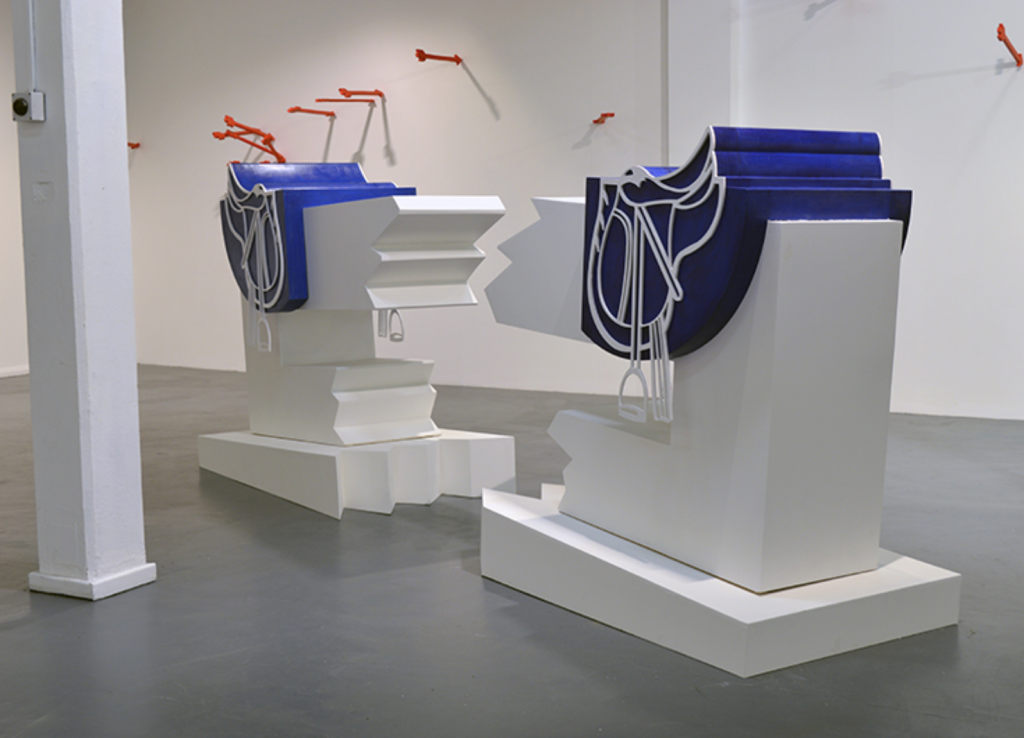
Liam Fallon: Supersymmetry
The Turnpike, Leigh
What is love?
Baby don’t hurt me
Don’t hurt me
No more
– Haddaway
A flurry of red arrows haphazardly jut from the walls of Liam Fallon’s first solo exhibition ‘Supersymmetry’. Protruding from all angles, these cartoonish jesmonite sculptures punctuate the exhibition like an accumulation of small, fleeting gestures. The title of the work, ‘Aftermath’ (2019), suggests retrospective reflection, but its execution playfully fuses the infatuation and sexual desire of Eros – along with a heady dose of heartbreak. Usefully, the arrows also provide a cylindrical flow to the exhibition that weaves together the varied narratives.
Supersymmetry is the manifestation of three years of dialogue between Fallon and curator Matt Retallick. Its title is inspired by the – increasingly contentious – theory in particle physics that each particle can be paired with a perfect partner. Optimistically adopting this theory, Fallon takes us on a sculptural odyssey encompassing love, sexuality and sentimentality.
There is a purposeful ambiguity to the work, with Fallon’s adroit craftsmanship critical to achieving this. His disarming cartoon aesthetic is underpinned by a semiotic consideration of materiality and objecthood. Masculine motifs such as zips, buckles and saddles are rendered and deftly loaded with contrasting narratives. This collision sparks emotive responses to work that feels familiar yet entirely fresh.
‘Tongue Tied’ (2019) incorporates a baby blue, wipe-clean mattress with two cavities. Hanging low, a pair of silicone cigarettes are evocatively drooped over each other, brimming with sexuality. ‘His and His’ (2019) features two highly polished monumental male belt buckles in intimate proximity. Holding contrasting emotions of intimacy and publicness, these works are representative of the tension between public and private space in Fallon’s practice. ‘Lovers Carving’ (2019) consists of three bronze jesmonite slabs hung together, the work is adorned with carved tally marks and symbols. Plastic birds sit on perches that jut out. These elements constitute a private language that is relatable – the juvenile act of declaring your devotion in the public realm – yet one that we cannot understand.
‘A Few Golden Moments’ (2019) encapsulates the barrage of emotions surging through Fallon’s work. Tinged water is circuitously pumped from clear plastic tubes through a jagged, jet-black brick façade, into two adjoining buckets. Playfully suggestive of sexual acts and bodily fluids in title and execution, the work seems to ruminate deeper on how primarily queer space, is produced and, crucially, lived. In this vain, Fallon’s work belongs to linage such as photographer Alvin Baltrop, whose work embodied the very public and private dichotomy of queer culture and space.
This is explored further in ‘La Saudade’ (2019) – a Portuguese term which roughly translates as a melancholic longing for a former lover – a monumental sculpture which serves as the narrative climax. A white sculpture fragments into two pieces that are slipping away, each topped with a blue saddle. A very public breakup. If the monument is a civic representation of space, Fallon appears to suggest that it’s the minutiae of everyday life – and love – that defines space, especially those spaces forged in the face of systemic prejudice.
Jack Welsh
Jack Welsh is a freelance arts producer and writer based in Liverpool.
This review was published on Corridor8.
Image: Liam Fallon, ‘La Saudade’ (2019) installation view.